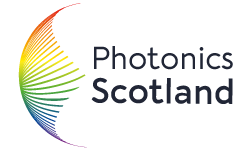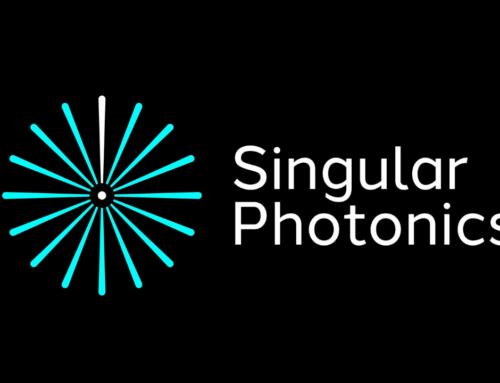
Photonics Scotland has been working with our friend and collaborator, Dr Kirsty Annand, on the ‘Opening Up Photonics’ (OuP) initiative since it’s inception in 2018 and is delighted to share this blog by The Future Photonics Hub in which Kirsty shares insight into the OuP initiative, the importance of a diverse workplace and more. We very much look forward to continuing our work on this important initiative with Kirsty and our partners.
Dr Kirsty Annand is the driving force behind Opening Up Photonics, an initiative that is helping the photonics industry attract a more diverse workforce, with a particular focus on closing the sector’s gender gap.
Kirsty, who is External Engagement Manager for the Photonic Integration and Advanced Data Storage Centre for Doctoral Training, explains how Opening Up Photonics came about, and how supporting the sector to appeal to a broader demographic will help address skills shortages and harness the fresh thinking that diverse teams bring.
Tell us about your career to date
After a PhD at the University of Glasgow in materials and condensed matter physics, I spent 12 months there as a Knowledge Exchange Associate specialising in semiconductor photonics. This involved developing partnerships with companies and stakeholders in the industry, giving me lots of insight into the skills industry needs.
I’m bringing that insight to my current role, External Engagement Manager for the Photonic Integration and Advanced Data Storage Centre for Doctoral Training (CDT). The CDT will train over 100 engineers and scientists to tackle the challenges created by the increasing quantities of data generated by today’s society. My role involves engaging with industry and supporting PhD students to enhance their skills; the direct impact I can have on developing and championing the future photonics workforce is really exciting.
What is Opening Up Photonics all about?
In a nutshell, Opening Up Photonics is a platform that supports the photonics industry in tackling equality, diversity and inclusivity challenges to help it become more accessible to everyone, and that champions the positive impact a more diverse workforce brings. It is supported by the University of Glasgow, Technology Scotland, the Institute of Physics and the KTN, and more recently, The Future Photonics Hub.
It began in 2018 predominantly to highlight the lack of gender diversity in photonics, particularly in Scotland but also in the UK more broadly.
What action is it taking to narrow the gender gap?
We held our first workshop in October 2018, bringing together over 50 industry and academic experts, particularly those with a recruiting role. The general consensus was that companies acknowledged the benefits of a diverse workforce but didn’t know how to make it happen.
Since then we have partnered with Equate Scotland, the national experts in gender and diversity in STEM, to run workshops with clear, actionable objectives to help organisations improve their approach to gender diversity. Equate Scotland has resources available online that companies can download to check that they’re ticking off the criteria for a fair job description, for example, or following good interviewing practice.
What are the future plans for the initiative?
Our aims include building up our profile with industry, academia and government, encouraging organisations to sign up to our vision for growth in photonics, identifying barriers to female engagement in the sector, and equipping HR teams with tools and resources so they can attract a more diverse workforce. Engaging with education providers to inspire future generations of photonics professionals is also key, because children make choices at a really young age about whether they want to continue to study science. We want to make sure we’re making an appropriate impact at an appropriate point in the pipeline.
What prompted you to establish Opening Up Photonics?
It stemmed in part from my experience as a young women starting a career in photonics. There seemed to be so many jobs that just didn’t fit me, and I felt I didn’t have a clear direction. Meanwhile Photonics Scotland was reporting a lack of skills to fill jobs in the sector. There was clearly a disconnect that I thought we should try to unpick.
Industry figures reflect this disconnect. Photonics is worth £1bn in Scotland, employing 4,000 people, and Photonics Scotland has delivered a white paper to government with a goal of trebling the size of the Scottish sector. But photonics, like many other science and technology sectors, has struggled to engage with a number of key demographics when it comes to recruitment – a recent study by SPIE (the International Society for Optics and Photonics) indicated that female representation in the sector across Europe is as low as 20 per cent.
Why is diversity in photonics so important?
A diverse team brings diverse thinking. If you have the same people around the table every day, who have the same background and privileges, it’s likely they will all have the same opinion. But if you have people from different parts of the world, with different ethnicities, backgrounds, genders, religions, and different levels of privilege, they challenge what’s already been done. And there’s lots of evidence linking greater diversity with higher profits.
How did you get into photonics?
In high school I didn’t even know what photonics was! I stumbled into it purely by accident, due to some experience during my PhD of characterising samples my colleagues were producing, which happened to be for semiconductor lasers.
At school I really enjoyed science and figuring out how things work, and my mum encouraged my love for science, which was super helpful. When I got to the age of 12 or 13, when there’s pressure to choose more ‘artsy’ subjects that other girls would be doing, my mum would be asking me to tell her about the interesting things I had learned in my science classes. That was really important, because it’s natural for a lot of mums to say to their daughters that maybe they shouldn’t choose physics because none of their friends are doing it, or they won’t enjoy it.
What role are you playing in encouraging more girls to study science?
I’m STEM ambassador for the CDT and we do a lot of science outreach with the public, including in schools. We need to get young people – including girls – engaged, excited and educated about working and studying photonics, so they realise it’s not a scary word and they understand the exciting and fulfilling career possibilities across the sector.
One of the things we’ve learned is that teachers are looking for outreach activities with some longevity, something hands-on and creative that gets young people to think outside the box. It’s also important to tie it in with the school curriculum, so teachers can link their science lessons to the topics covered in your workshop or demonstration.
What is your experience as a woman in photonics?
I’ve had quite a positive experience in photonics and STEM so far. I’m lucky that I have really great male and female role models around me in my work life and personal life. I’m also lucky that I’m a fairly outgoing person, and I’m getting a bit better at networking and learning to lock away my imposter syndrome when I’m talking to people who know more than I do!
One thing I’ve had to do, when I’m applying for jobs, is to take a step back from job adverts and think about what the company is actually asking for. Research shows that men tend to apply for jobs even if they don’t meet all the essential criteria, whereas women feel they have to meet or exceed the criteria before they’ll apply. I realised that I’d been subconsciously doing that every time. I would read job adverts and think “that’s not for me”. I didn’t relate to the language they used, and they seemed to be looking for someone more confident, or more of an achiever. So I’ve had to be proactive about getting past the adverts and instead phoning up the hiring manager to find out what they’re really looking for.
What advice would you give to young women thinking about working in photonics?
- Do what you love – it always works out.
- Seek out mentors, whether it’s at home, at school, family members or teachers, who you can talk to and ask questions.
- Network. It doesn’t come easily to most people, even if you’re naturally quite outgoing, but it’s so important. Get onto whatever online platform works for you – LinkedIn or Twitter for example – and use it. Talk to everybody you can, ask questions and follow up on conversations.
Why is the work being done by The Future Photonics Hub to encourage collaboration across the sector so important?
In my experience the photonics sector is quite disjointed – there are a few big players and lots of really great SMEs doing incredible stuff. But that disconnect means that trying to embed multiple photonic technologies into one platform, while not impossible, is more difficult. The cross-pollination of ideas, expertise, and facilities that The Future Photonics Hub is promoting will inevitably lead to the creation of unique solutions with many applications across technology platforms.
Twitter @UofGlasgow





